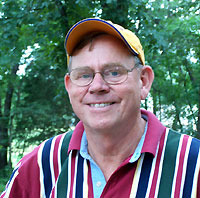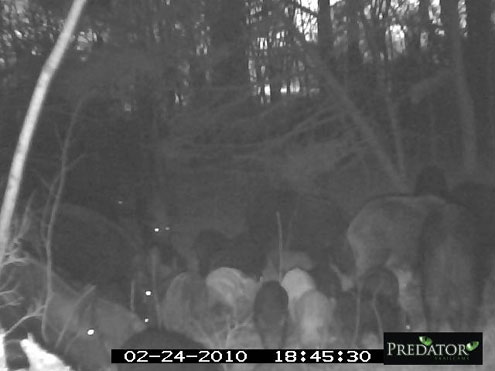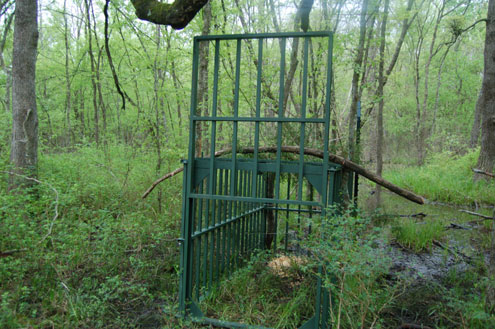
I love hunting them for sport and eating them for food! Now, Since my apologies are out of the way, maybe Iíve got a saving grace in your eyes: I hunt them year-around and, since the hogs in my area have become almost entirely nocturnal, I am now trapping them! I do my share to reduce their numbers, of this you can rest assured!
Maybe I love having wild hogs around because of the fact that I was raised on a farm in northeast Texas back in the 50ís and 60ís when pork was a staple meat for my family. My dad always raised six or eight hogs each winter and usually butchered half of them for our winterís supply of meat, the others he sold as a cash crop. Pork was a commodity and hogs were highly revered. There were a few wild porkers in our area of the state at the time, mostly along the river drainages but they were not nearly as plentiful as today. Iím sure if my dad was still around, he would look at all the hogs roaming the wilds of Texas today as free meat on the hoof. So, donít be too mad at me for LOVING wild hogs, Iím doing my share to reduce their numbers.
I have a couple of feeders set within a mile of my home and have monitored the hogís movement closely the past several months via trail cameras. In the past three months, Iíve seen only one hogís image on the trail camera during daylight hours. They are almost entirely nocturnal but they are extremely plentiful.
Back in February, I began seeing sows with 8-10 piglets around the feeders. One image from the trail camera contains 22 hogs and there is no telling how many were just outside the cameraís view. Iíve shot several at night using a Feedlight (www.ultramaticfeeders.com) which is a light that attaches to a feeder or nearby tree and comes on automatically when the sun goes down.

My friend Karl Harmon invented this innovative light years ago and there is no telling how many hogs have been killed over them at night. Iíve even shot a couple using a night scope on my .22 Hornet rifle.
A month or so ago, I decided I wanted to begin trapping hogs for meat. The more I checked into traps, the more disappointed I became. I wanted to trap along a well-used hog trail back in heavy cover and every trap I found weighed far too much to transport into the backwoods. My search finally led me to Air-Lite Aluminum Hog Traps (www.gaterboy.com), a company in Florida owned by Kent and Nancy Collins.
After looking at the traps on the internet and visiting with the couple on the phone, I decided they made exactly the trap that I was looking for. I chose a 6 foot trap that is 34 inches wide and weighs about 50 pounds. Because of their light weight, these aluminum traps are economical to ship. My desire was to catch one or two hogs at a time. I had no need for a huge trap for catching multiple hogs. When my trap was delivered, I broke out my ratchet and seven-sixteenth inch socket, a box end wrench and had the trap assembled in 20 minutes.

I could have just as easily packed it into the woods and assembled it on the spot, but I knew a route where I could snake the trap through the trees and place it near my corn feeder.
I brought along a tape measure and easily located a couple of small saplings that measured 36 inches apart. I lucked out and found another small tree three feet behind these two. I had three very permanently anchored Ďsupportsí to wire my lightweight trap to, a T Post insured the trap would stay in place, even if I did catch a 200 pound boar. For added security, I cut a cedar limb and placed it across the top of the trap, wiring it to the two saplings.
I used a game cart from Bass Pro Shops to transport the assembled trap the quarter mile or so to the feeder. Thereís nothing wrong with using an ATV but I like and need the exercise that walking affords. Besides, I like the idea of slipping quietly into and out of an area where I am hunting or, now, trapping.
The door on my trap has a hole into which fits a tapered pin. A string or wire is attached to the pin, once the gate is up, the other end of the string is attached to a horizontal Ďtripí wire near the back of the trap, about 18 inches up from the ground. I baited a string of corn into the trap and piled up plenty more in the back of the trap, just behind the trip wire. I added a little raspberry flavored Kool Aid to make the food source even more enticing. The trap was placed and set yesterday and I aimed my trail camera to photograph the front of the trap.
This morning, I checked my trap and found the trap door still up and no images on the trail camera; the hogs decided not to visit my set up last night. I left the spring woods quietly early this morning but my expectations are high for tomorrow. Those hogs seldom stay away from that corn feeder more than 2 nights. I can already taste the pulled pork on my Smokin Tex electric smoker!
Listen to Outdoors With Luke Clayton at www.catfishradio.com. Contact Luke at lukeclayton@prodigy.net
OUTDOOR TIP OF THE WEEK - Transporting hunting and fishing gear into remote areas can be a challenge. I hunt and trap wild hogs close to my home and find these wary critters a good bit off the beaten path. I donít own and ATV, and Iíve had some tough times dragging the larger hogs out; Iíve even quartered a few of the larger hogs in the woods and packed the meat out in pieces. While fishing for spawning white bass a few years ago, a buddy taught me that a wheelbarrow makes a good means of getting all the fishing equipment and catch back out.
But wheels are small on a wheelbarrow and pushing one through uneven terrain is tough. Iíve recently discovered the answer to my problem. Iíve been using a Magnum Game Cart by Redhead. With oversized tires, this lightweight but strong cart makes transporting gear and game into and out of the back country easy.
I recently used my cart to transport a six-foot hog trap a quarter mile and, two days later, easily hauled the meat from a 150-pound hog I trapped.